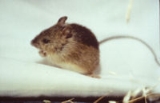
Zapodidae
Encyclopedia
Jumping mice are a group of mouse-like rodent
s in North America
and China
.
Although mouse-like
in general appearance, these rodents are distinguished by their elongated hind limbs, and, typically, by the presence of four pairs of cheek-teeth in each jaw. There are five toes to all the feet, but the first in the fore-feet is rudimentary, and furnished with a flat nail. The tail makes up for 60% of its body length and is used to gain balance while bounding. The cheeks have pouches. The Sichuan
jumping "Yeti" mouse (Eozapus setchuanus) from China can be identified by the ‘Y’ marking on its belly.
In America these rodents inhabit forest, pasture, cultivated fields or swamps. When disturbed, they start off with enormous bounds of eight or ten feet in length, which soon diminish to three or four; and in leaping the feet scarcely seem to touch the ground. they are nocturnal and generally live alone. The nest is placed in clefts of rocks, among timber or in hollow trees, and there are generally three litters in a season.
Rodent
Rodentia is an order of mammals also known as rodents, characterised by two continuously growing incisors in the upper and lower jaws which must be kept short by gnawing....
s in North America
North America
North America is a continent wholly within the Northern Hemisphere and almost wholly within the Western Hemisphere. It is also considered a northern subcontinent of the Americas...
and China
China
Chinese civilization may refer to:* China for more general discussion of the country.* Chinese culture* Greater China, the transnational community of ethnic Chinese.* History of China* Sinosphere, the area historically affected by Chinese culture...
.
Although mouse-like
Muroidea
Muroidea is a large superfamily of rodents. It includes hamsters, gerbils, true mice and rats, and many other relatives. They occupy a vast variety of habitats on every continent except Antarctica. Some authorities have placed all members of this group into a single family, Muridae, due to...
in general appearance, these rodents are distinguished by their elongated hind limbs, and, typically, by the presence of four pairs of cheek-teeth in each jaw. There are five toes to all the feet, but the first in the fore-feet is rudimentary, and furnished with a flat nail. The tail makes up for 60% of its body length and is used to gain balance while bounding. The cheeks have pouches. The Sichuan
Sichuan
' , known formerly in the West by its postal map spellings of Szechwan or Szechuan is a province in Southwest China with its capital in Chengdu...
jumping "Yeti" mouse (Eozapus setchuanus) from China can be identified by the ‘Y’ marking on its belly.
In America these rodents inhabit forest, pasture, cultivated fields or swamps. When disturbed, they start off with enormous bounds of eight or ten feet in length, which soon diminish to three or four; and in leaping the feet scarcely seem to touch the ground. they are nocturnal and generally live alone. The nest is placed in clefts of rocks, among timber or in hollow trees, and there are generally three litters in a season.
Classification
Subfamily Zapodinae, Jumping mice- Genus Eozapus
- Chinese Jumping MouseChinese Jumping MouseThe Chinese Jumping Mouse is a species of rodent in the Dipodidae family. It is monotypic within the genus Eozapus.It is endemic to China. Its natural habitat is temperate forests.It is threatened by habitat loss....
, Eozapus setchuanus
- Chinese Jumping Mouse
- Genus Napaeozapus
- Woodland Jumping MouseWoodland jumping mouseThe Woodland jumping mouse is a species of jumping mouse found in North America. It can hop surprisingly long distances given its small size. The mouse is an extraordinary part of the rodent family. Its scientific name in Latin is Napaeozapus insignis, meaning glen or wooded dell + big or strong...
, Napaeozapus insignis
- Woodland Jumping Mouse
- Genus ZapusZapusZapus is a genus of North American jumping mice. It is the only genus whose members have the dental formula: Zapus are the only extant mammals with a total of 18 teeth ....
- Meadow Jumping MouseMeadow jumping mouseThe meadow jumping mouse is the most widely distributed mouse in the subfamily Zapodinae. It may be found from the Atlantic coast, to the Great Plains, as far north as the arctic tree lines in Canada and Alaska, and as far south as Georgia, Alabama, Arizona, and New Mexico.- Description :The...
, Zapus hudsonius - Western Jumping MouseWestern Jumping MouseThe Western Jumping Mouse , is a species of rodent in the Dipodidae family. It is found in Canada and the United States....
, Zapus princeps - Pacific Jumping MousePacific Jumping MouseThe Pacific Jumping Mouse is a species of rodent in the family Dipodidae. It is found in Canada and the United States. Its natural habitats are temperate grassland and swamps....
, Zapus trinotatus
- Meadow Jumping Mouse

